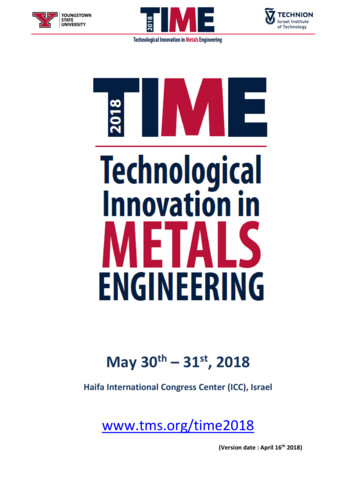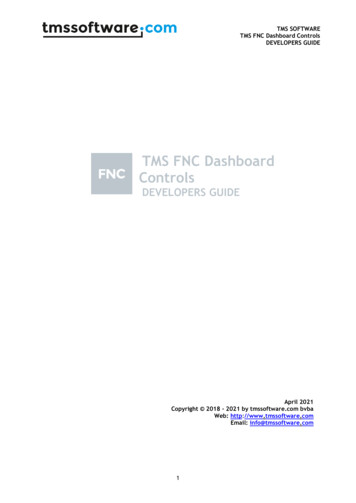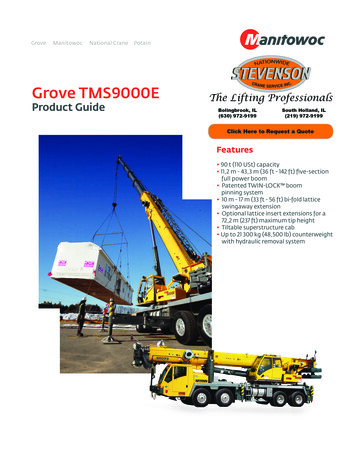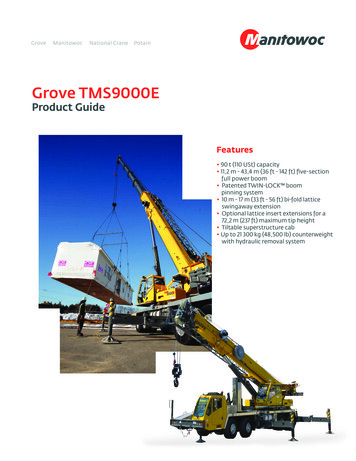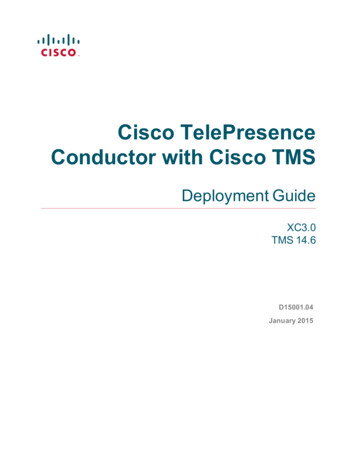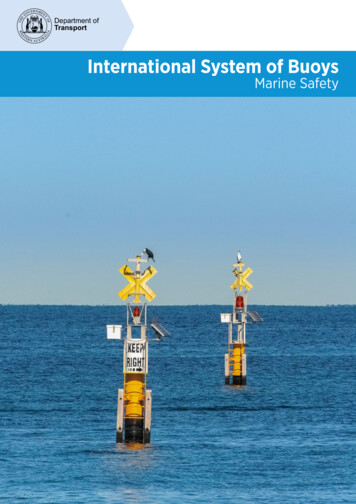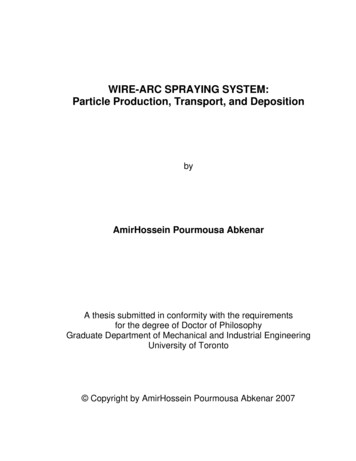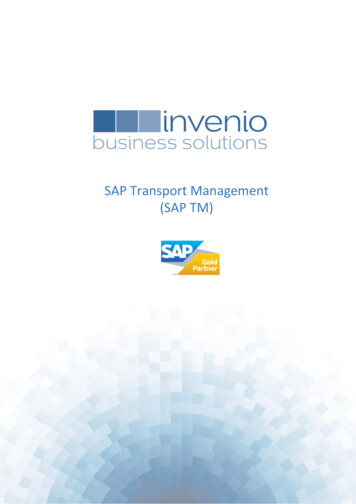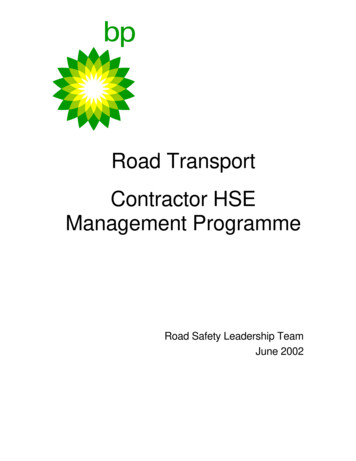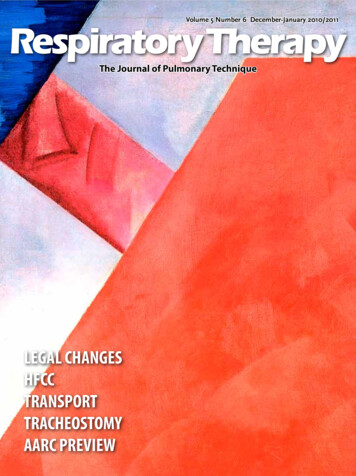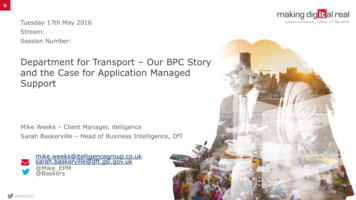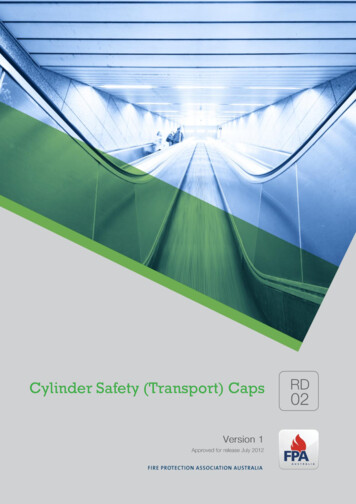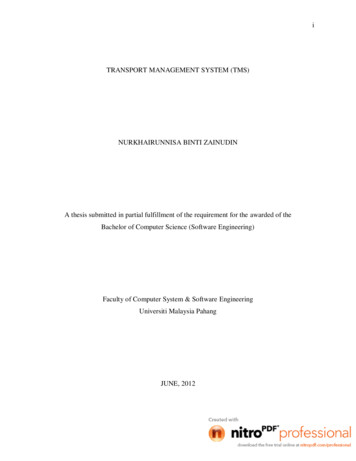
Transcription
iTRANSPORT MANAGEMENT SYSTEM (TMS)NURKHAIRUNNISA BINTI ZAINUDINA thesis submitted in partial fulfillment of the requirement for the awarded of theBachelor of Computer Science (Software Engineering)Faculty of Computer System & Software EngineeringUniversiti Malaysia PahangJUNE, 2012
viABSTRACTSetiausaha Kerajaan Negeri Pahang (SUK) is an organization that is responsible tomanage the transportation for other communities such as Institut KemahiranIkhtisas Pahang (IKIP), Kolej Islam Pahang Sultan Ahmad Shah (KIPSAS), KolejPoly-Tech MARA (KPTM) and etc. which are under Setiausaha Kerajaan NegeriPahang (SUK). It manages the operational of the transportation in matter ofbooking transport. There are several problems identified when using the manualsystem. Time to book is limited to working hours when user wants to apply it.Problem occurs when transports have mechanical problems are rented, vehicles thathave been double booked and there have been cases when the wrong vehicle hasbeen rented when it has been returned and not serviced. The current system hasredundancy, where data cause by the manual system which uses paper to fill theinformation. Data is also not being kept in the secure location. Information lost iscommon by using manual system. For the solution of the problems, TransportManagement System (TMS) is developed to manage the operational of thetransportation in matter of booking process. TMS is a web-based applicationsystem. The significant of the system allows the admin, staff, normal user anddriver to check the availability of transport directly. Data will be stored in adatabase. To develop this system, Rapid Application Development (RAD) modelhad been chosen as a methodology. Hopefully this system can be really helpful andprovide services and satisfaction to the user.
viiABSTRAKSetiausaha Kerajaan Negeri Pahang (SUK) adalah sebuah organisasi yangbertanggungjawab untuk menguruskan pengangkutan bagi komuniti seperti InstitutKemahiran Ikhtisas Pahang (pendiri), Kolej Islam Pahang Sultan Ahmad Shah(KIPSAS), Kolej Poly-Tech MARA (KPTM) dan sebagainya, yang berada dibawah Setiausaha Kerajaan Negeri Pahang (SUK). Ia menguruskan operasipengangkutan dalam tempahan kenderaan. Terdapat beberapa masalah yang dikenalpasti apabila menggunakan sistem manual. Masa untuk tempahan adalah terhadsemasa waktu kerja sahaja apabila pengguna mahu membuat pinjaman. Masalahberlaku apabila pengangkutan yang disewa mempunyai masalah mekanikal,kenderaan yang ditempah berulangkali dan terdapat kes apabila kenderaan yangtidak betul telah disewa dan tidak diservis. Sistem sedia ada mempunyai kelebihan,dimana sistem manual menggunakan kertas untuk mengisi maklumat. Data jugatidak disimpan di tempat yang selamat. Kehilangan maklumat adalah perkara biasaapabila menggunakan sistem manual. Bagi penyelesaian masalah, SistemPengurusan Pengangkutan (TMS) yang dibangunkan adalah untuk menguruskanoperasi pengangkutan dalam proses tempahan. TMS adalah satu sistem aplikasiberasaskan web. Sistem ini membolehkan admin, kakitangan, pengguna biasa danpemandu memeriksa status pengangkutan secara terus. Data akan disimpan ohonanRapidPembangunan (RAD) model telah dipilih sebagai metodologi. Semoga sistem iniboleh membantu dan memberikan perkhidmatan dan kepuasan kepada pengguna.
viiiTABLE OF CONTENTSCHAPTER12TITLEPAGETITLE PAGEiSUPERVISOR’S DECLARATIONiiSTUDENT’S viABSTRAKviiTABLE OF CONTENTSviiiLIST OF TABLESxiiLIST OF FIGURESxivLIST OF APPENDIXESxviINTRODUCTION11.1 Project Background11.2 Problem Statement21.3 Objective21.4 Scope31.5 Thesis Organization4LITERATURE REVIEW52.1 Introduction52.2 Current and Existing System6
ix2.2.1 School Asset Manager62.2.2 Transport Management72.2.3 Demo Golden Inventory System82.2.4 Summary of Current System92.3 Application Background Idea102.3.1 Web Application112.3.2 Knowledge Management112.3.3 Procurement Management System112.3.4 Asset Management System / Inventory Management System122.3.5 Content Management System Software122.4 Platform122.4.1 Operating Systems122.4.1.1 Windows132.4.1.2 Linux132.4.1.3 Macintosh142.4.1.4 Comparison between Linux, Window and Mac142.4.2 Web Browser152.4.2.1 Google Chrome152.4.2.2 Internet Explorer152.4.2.3 Mozilla Firefox162.4.2.4 Comparison between Google Chrome, MozillaFirefox and Internet Explorer2.5 Programming Languages16172.5.1 PHP172.5.2 JSP172.5.3 ASP.NET182.5.4 Comparison between PHP, JSP and ASP182.6 Database Management Tools182.6.1 MySQL192.6.2 Oracle192.6.3 Comparison between MySQL and Oracle19
x2.7 Web Servers212.7.1 Apache212.7.2 XAMPP222.7.3 Internet Information Services (IIS)222.8 Software Development Methodology3232.8.1 Waterfall Model232.8.2 Prototyping Model242.8.3 Rapid Application Development (RAD)262.8.4 Comparison between Waterfall, Prototyping and RAD292.9 Conclusion30METHODOLOGY313.1 Introduction313.2 Rapid Application Development (RAD)323.3 The Justification of RAD323.4 Phases of RAD333.4.1 Requirement Planning Phase343.4.2 User Design Phase383.4.3 System Modules383.4.3.1 User Registration Module383.4.3.2 Register Staff Module403.4.3.3 Create Session Module413.4.3.4 Online Booking Module433.4.3.5 User Transaction Approval Module443.4.3.6 View Receipt Module453.4.3.7 Booking Cancellation Module473.4.3.8 Produce Management Report Module483.4.3.9 Manage User Profile Module503.4.3.10 Manage Transport Operation Module513.4.3.11 Task Assignment Module52
xi3.4.3.12 Manage User Booking Module3.4.3.13 Search User Module4554553.4.4 Construction Phase563.4.5 Cutover Phase573.5 Development Tools583.5.1 Software Tools583.5.2 Hardware Tools593.6 Conclusion60IMPLEMENTATION614.1 Introduction614.2 Database Construction624.3 User Interface Construction674.4 Conclusion77EXPECTED RESULT, DISCUSSION AND CONCLUSION785.1 Introduction785.2 Expected Result785.2.1 System Test Case795.3 Discussion825.4 Conclusion82
xiiLIST OF TABLESTABLE NO2.1TITLEPAGEComparison between School Asset Manager,Transport Management and Demo Golden Inventory System92.2Comparison between Linux, Window and Mac142.3Comparison between Google Chrome,Mozilla Firefox and Internet Explorer162.4Comparison between PHP, JSP and ASP182.5Comparison between MySQL and Oracle192.6Advantages and disadvantages of Waterfall Model232.7Advantages and disadvantages of Prototyping Model252.8Rapid Application Development Phases262.9Advantages and disadvantages of Rapid Application Development282.10Comparison between Waterfall, Prototyping and RAD293.1Use Case Description for User Registration393.2Use Case Description for Register Staff403.3Use Case Description for Create Session423.4Use Case Description for Online Booking433.5Use Case Description for User Transaction443.6Use Case Description for View Receipt463.7Use Case Description for Booking Cancellation473.8Use Case Description for Produce Management Report493.9Use Case Description for Manage User Profile503.10Use Case Description for Manage Transport Operation513.11Use Case Description for Task Assignment533.12Use Case Description for Manage User Booking54
xiii3.13Use Case Description for Search User553.14List of Software Requirements Used in the System583.15List of Hardware Requirements Used in the System595.1System Test Cases79
xivLIST OF FIGURESFIGURE NOTITLEPAGE2.1Literature Review Structure52.2School Asset Manager (Home Page)62.3Transport Management (Home Page)72.4Demo Golden Inventory System82.5Waterfall Model232.6Prototyping Model242.7Rapid Application Development (RAD)263.1Flow of Rapid Application Development (RAD)333.2Transport Management System Context Diagram353.3Transport Management System Use Case Diagram373.4User Registration Use Case Diagram383.5Register Staff Use Case Diagram403.6Create Session Use Case Diagram413.7Online Booking Use Case Diagram433.8User Transaction Approval Use Case Diagram443.9View Receipt Use Case Diagram463.10Booking Cancellation Use Case Diagram473.11Produce Management Report Use Case Diagram483.12Manage User Profile Use Case Diagram503.13Manage Transport Operation Use Case Diagram513.14Task Assignment Use Case Diagram533.15Manage User Booking Use Case Diagram543.16Search User Use Case Diagram554.1Entity Relationship Diagram (ERD) of TMS63
xv4.2Structure for database ekenderaan644.3Structure for user Table644.4Structure for pinjamkenderaan Table654.5Structure for daftarkenderaan Table664.6Structure for daftarkenderaan Table674.7Main Interface (Home) of TMS684.8Connection to database684.9Connection to database when assign the user694.10Session to assign the user694.11Register Interface704.12Login Invalid Interface704.13Login Interface714.14Add user info to database714.15Edit Profile Interface724.16Add pinjamkenderaan info to database724.17Online Booking Interface734.18Select daftarkenderaan info to display734.19Print field in daftarkenderaan table to display744.20User Transaction Interface744.21Manage Transport Operation (Daftar) Interface754.22Manage Transport Operation (Papar) Interface754.23Update daftarkenderaan table to delete764.24Manage Transport Operation (Lupus) Interface76
xviLIST OF APPENDIXESAPPENDIXTITLEPAGEAGantt Chart84BReferences85CManual Booking Form90DUser Manual91ESRS92FSDD93
1CHAPTER 1INTRODUCTIONThis chapter explains briefly about background, problem statement, the objective,scope and thesis organization of the Transport Management System (TMS) project.1.1Project BackgroundNowadays, system of the transportation uses the manual system where needs to fillall records in a file from the system users to the technical writers [1]. This work is handledby staff to fill all the transport reservation form with handwriting. This will give difficult tofind file when the same customer come to book transport again.Transport Management System (TMS) is a system to effectively manageinformation about customer profile and make reservation easily. It also manages thetransportation system for other communities such as Institut Kemahiran Ikhtisas Pahang(IKIP), Kolej Islam Pahang Sultan Ahmad Shah (KIPSAS), Kolej Poly-Tech MARA(KPTM) and etc. which are under Setiausaha Kerajaan Negeri Pahang (SUK) [2]. Customeralso can see types of transport that can be booked with faster and make the choice of thetransport. Customer does not need to register many times because the profile customer hasbeen saved into database. This systems focus as a reservation form and latest informationabout the transport availability.
2The information management system provides to implement process [3] ofTransport Management System (TMS) reservation form that user request. The data thatmust be sent include pick-up date, drop-off date, transport types, how long to rent, methodof payment, and etc. This data must be sent to supplier rental companies. Then, informationmanagement system also controls the user request that must be completed by customer.Customer’s profile can be updated any time. When user completes it, the data must besubmitted to the rental companies system.1.2Problem StatementTransport Management System (TMS) has design to manage the booking andmaintenance of growing transport. Problem occurs when transports have mechanicalproblems are rented, vehicles that have been double booked and there have been caseswhen the wrong vehicle has been rented when it has been returned and not serviced. Thecurrent system has redundancy, where data cause by the manual system which uses paper tofill the information. Data is also not being kept in the secure location. Information lost iscommon by using manual system. The efficient planning and management of anorganization's transport system is the key to providing a proficient transport network.Transport systems should ensure accessibility at an acceptable level of safety and comfort,in an environment-friendly manner for the movement of people. Additionally it encouragespatterns of growth and economic activity by providing access to communities. Hopefullythis system improves customer service and satisfaction.1.3ObjectiveThe objectives of the project are:i.Develop Transport Management System (TMS) to adapt Setiausaha KerajaanNegeri Pahang (SUK) to book transport and save data easily.
3ii.To assist Setiausaha Kerajaan Negeri Pahang’s transport managers to efficientlyplan and manage their organizations.iii.1.4To save user data and information efficiently in real-time data retrieval.ScopeTransport Management System (TMS) is to centralize and manage thetransportation system for other communities such as IKIP, KIPSAS, KPTM and etc. whichare under Setiausaha Kerajaan Negeri Pahang (SUK). This system is a web-basedapplication [4]. People can register through the online form. Then, they will get the detailabout the transport.There are three scopes for this project:i)AdminAdmin can update, delete and add customer profile any time, rates a car andbooking in this system. Besides that, admin can make a vehicle service alert andreporting function to display vehicle usage.ii)UserCustomer can view and update their profile after register if they want to changesome information. In addition, they can book a transport after login, choose thetransport that they want to book anytime and they can update booking to changethe data.iii)SystemThis system consists of 12 modules. There are modules for admin, staff anduser. This system is an online system that customer can view the page any time.
4This system has their advantage because customer can read the informationeasily.1.5Thesis OrganizationThis thesis consists of six (6) chapters. Chapter 1 will discuss on introduction tosystem. Problem statement describes on the problem that faced by the current system.Chapter 2 is literature review that discusses on current system and the technique orthe software that will be used on the current system.Chapter 3 elaborates on system methodology. It is defining on the method used todevelop the system and project pl
TRANSPORT MANAGEMENT SYSTEM (TMS) NURKHAIRUNNISA BINTI ZAINUDIN A thesis submitted in partial fulfillment of the requirement for the awarded of the Bachelor of Computer Science (Software Engineering) Faculty of Computer System & Software Engineering Universiti Malaysia Pahang JUNE, 2012 . vi ABSTRACT Setiausaha Kerajaan Negeri Pahang (SUK) is an organization that is
